RePlayed: Enslaved: Odyssey to the West
Some games can do everything right, from narrative to combat, to character and world design, and yet still fail to resonate with the mighty gestalt beast that is the gaming public. Regardless of production values, big names attached to the cast or crew, or even the source material upon which they’re based, some titles just can’t catch that break when it comes to sales. Even a game that can score as high as 8 or 9 in almost every single review, and elicit smiles and nods and assertions of “Ah, that was an excellent game” every time its name is mentioned just can’t shift enough units to be certified a “success”. As a some-time champion of such titles, I could reel off a list as long as your left leg of games that should have been instant classics, yet were relegated to the bargain bin in record time.
At the top of that list, always, is Ninja Theory’s Enslaved: Odyssey to the West, one of the great tragedies of the last decade. Despite solid review scores, the heavyweight talents of screenwriter Alex Garland (notably of The Beach and 28 Days Later fame), and motion-capture master Andy Serkis, Enslaved failed to shift even half of its million copy target in its first month and, regardless of how high such a number seems to you or I, simply underperformed. With Ninja Theory subsequently hired to rework Capcom’s Devil May Cry series into this year’s reboot and Namco Bandai shifting their focus to hardcore dungeon-crawler Dark Souls, Enslaved was shelved, its rich world put on hiatus, its colourful characters discarded in favour of more lucrative pursuits.
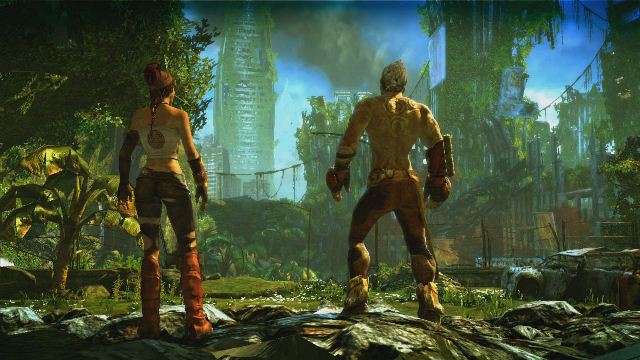
WEST SIDE STORY: Enslaved is loosely based on Wu Cheng’en’s 16th Century Chinese novel, Journey to the West, about a young man who must travel into unknown lands, protected by three warriors who themselves are atoning for past sins. The most notable of the three is Monkey, a former God who must be controlled by a magical ring that will cause him great pain should he attempt to abandon his duty. Enslaved strips most of that away, leaving only the core concept of a weak character forcing a strong character into the role of protector and guide using pain as the primary motivation.
In this instance the weaker character is a young woman called Tripitaka, or Trip (played by Lindsey Shaw), who manipulates Andy Serkis’ world-weary brute Monkey into guiding her back home to her village by fitting him with a headband that will kill him instantly should he abandon her or let her die. The backbone of the story – and much of the gameplay – revolves around Monkey attempting to guide Trip through a post-apocalyptic United States.
The world of Enslaved is unique. Brightly-lit by the summer sunlight and overgrown by rampant vegetation, the America depicted here is one that exists 150 years after a race of self-aware machines wiped out most of the human race, leaving only roving packs of scavengers, slavers and thugs in a world heavily-populated by battle mechs. These mechs spend most of their time dormant – but are set permanently to kill, stuck in a looping routine that urges them to annihilate every human being they see. Despite the grim tone, the gorgeous, vivid art style prevents Enslaved from becoming too dark, juxtaposing the constant threat of death – either by the skulking mechs or the environment itself – with welcoming sunshine and vibrant visuals.
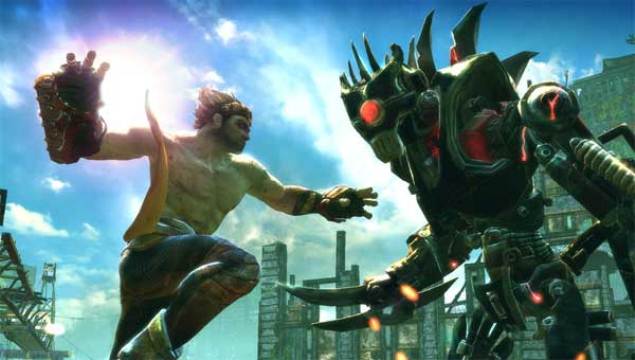
THEY CALLED ME ‘MONKEY’: The story begins aboard a slave ship high above the ruins of New York City, where Monkey awaits his arrival at Pyramid, a mysterious, distant place from which no one ever returns. During transit the ship enters a state of red alert as the tech-savvy Trip begins to override and deactivate certain fail-safes in order to bring it down. With the containment hold breached and electrical fires disrupting the ship’s functionalities, it isn’t long before Monkey finds himself free. Well, kind of free, anyway. After finding his impounded motorcycle and retrieving his gear, his journey to true freedom through the burning, deteriorating decks of the slave ship begins.
As the ship activates its combat mechs in response to the escaping prisoners, we’re given our first chance to control Monkey in combat, and despite the basic nature of the action – X for light attacks, Y for heavy, A to dodge, etc – it’s incredibly satisfying. Monkey moves with a unique grace that manages to combine his hulking weight with a nimbleness of foot normally only associated with exhibition martial artists. His movements are fluid and swift, yet brutal and uncompromising. Armed with an extendable quarterstaff and a pair of shock mitts that can stun mechs or generate a temporary physical shield, Monkey is a force to be reckoned with. Serkis brings the same kinetic energy to this role as he did to the titular giant ape in Peter Jackson’s King Kong, imbuing Monkey with an animalistic elegance that suffuses in his every leap and bound. He’s a physical powerhouse, a tattooed ruffian who seems oak-carved and imposing beside the more delicate Trip, but he’s also a survivor in a dangerous land who has learned how to roll with the punches.
The staff is a combo weapon, able to deliver a decent amount of damage fairly quickly by way of some rudimentary button combinations. The cadence of combat is in evading, blocking, countering with a charged stun move and then laying the beat down on the enemy as quickly as possible. Even when surrounded by multiple foes, combat is largely unchanged and can, as a result, feel a little staid by the half-way point. Luckily, actual fighting makes up a comparatively small percentage of the gameplay. Stealth elements feature frequently, as do environmental puzzles of the Prince of Persia persuasion, wherein straightforward platforming takes on a new dimension as you plot your way around an area, jump-point to jump-point.
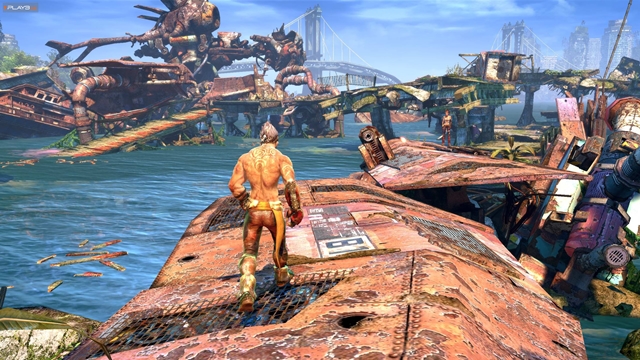
VERTICAL WORLD: Enslaved’s United States is an overgrown graveyard filled with junkers and slavers, derelict buildings, forgotten cities and windblown roads choked by giant weeds and creeping vines. Where many games would ask you to navigate such varied and unique environs on the ground floor – especially when the art is so alluring and, occasionally, breathtaking – Enslaved often takes its action upwards, sending Monkey scrambling up the sides of buildings or across huge antechambers wherein he’s forced to use the decaying rafters to avoid patrolling mechs.
The opening level aboard the slave ship is one of the best examples of this, and indeed it has been argued that Enslaved comes dangerously close to peaking too early. As Monkey pursues a fleeing Trip, looking for answers and a way to reach the last remaining escape pod, the ship is falling apart around him, often making it necessary to venture out onto the wings. Being a handy chap on his heels, there’s little danger of Monkey tumbling to an ungracious demise, but the first time you step outside and look around is one that I will never forget. It was at that moment, as black smoke billowed from a ruined engine and fire ravaged the hull of the enormous ship, as the distant buildings of NYC rose like jagged, grey teeth along the horizon, as I saw the great wide sky stretching out above me, reminding me that the epic struggle aboard the slave ship was nothing but one tiny event in a dying world on its way to Hell, that’s when I fell in love with Enslaved.
Leaping from wing to wing and battling mechs as clouds drift by beneath you is one thing, but scaling a crumbling section of the hull is something else entirely. The platforming is executed with precision, as slick and responsive as the combat, and Ninja Theory do as good a job as Naughty Dog of presenting the illusion that you land from every leap in the nick of time before your last known position is swept away in fire and bombast. As the game progresses there are other platforming set-pieces that come close to that opening – racing the crude yet likeable Pigsy to the top of a tower of junk in his scrapyard, for example, or mounting a dilapidated skyscraper with Trip holding tightly to your back, or surfing at high speed around an ocean liner graveyard, but none of those moments quite surpass it.
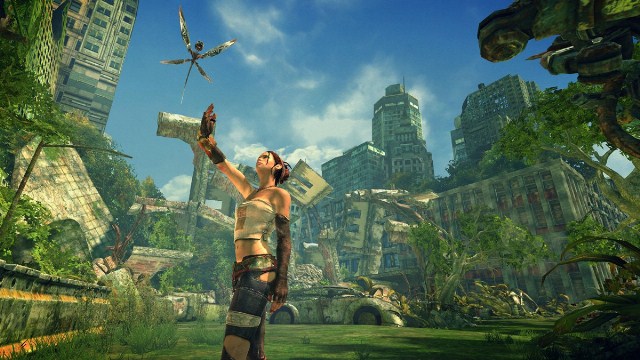
MONKEY, HELP ME: But despite big-budget set-pieces and cinematic flare, the real feather in Enslaved’s cap is the relationship between Monkey and Trip. Waking up after his escape pod smashes into the ground at high velocity, Monkey finds himself fitted with an ornate headband – the same model of headband that he earlier saw fry the brain of a slave who helped him to escape. Trip, ever resourceful and ever aware of her own limitations in this world, has essentially booby-trapped him, rigging him with a device that will kill him should he try to abandon her or allow her to be killed. With the headband in place, Monkey is forced to escort her the 300 miles back home, a journey characterised by predictable tension between the two leads.
Monkey himself is very much a product of the world in which he lives; not just standoffish but positively hostile to more or less every other living thing he encounters. He relies on no one, and drifts from place to place looking for nothing more than peace and quiet. The details of his past are never disclosed, but it’s clear that prior events have moulded him into what he is and then baked him in fire: he’s hard, sullen and aggressive. Trip is no wilting daisy either; she’s incredibly intelligent and highly resourceful, but she’s no fighter. Living her life in a walled village means she’s never had much call to fight mechs or navigate the treacherous world, and so she’s noticeably softer on the outside than Monkey, but her particular skill set makes her far more than just a damsel in distress.
For example, she’s able to activate an EMP to stun surrounding mechs when she gets in over her head, or scan an area for secrets and available pathways. Equipped to hack doors or reach areas otherwise impassable to Monkey due to his size, she’ll often have to be thrown across gaps or up onto higher ledges so that she can open the way. Keeping her alive is just as vital – though often much more difficult – than protecting Monkey, and yet the sense of equilibrium is maintained by the fact that, so often, without her Monkey would be in trouble himself. As a result, their relationship goes through various stages beginning with mutual distrust, then moving to reluctant co-dependence, grudging respect, and finally friendship – partly out of a new-found duty and partly out of companionship.

WE HAVE TO KEEP GOING: It’s after Trip makes it back to her village to find it overrun with mechs, her people dead or taken by slavers, that their relationship starts to change. Trip breaks her promise, refusing to remove Monkey’s headband and continuing his forced servitude right at the moment where he’s beginning to warm to her. Instead she makes him lead her to her father’s friend Pigsy, a scrap-hoarding grotesque (played by Richard Ridings) whose ill manners, sleazy one-liners and questionable hygiene hide a caring, surprisingly noble uncle figure. Along with Pigsy, Monkey and Trip set about infiltrating a mech base to steal a gargantuan weapon called the Leviathan, with which Trip intends to destroy Pyramid and free all of the slaves that have been taken there.
With the Leviathan in their possession, Trip attempts to deactivate the headband and free Monkey – who stops her, telling her to leave it on. The moment is tender, even romantic, and reveals a deeper side to Monkey’s abrasive, angry persona. Telling Trip to leave the headband on is his way of saying he wants to stay, but pretending he needs the restraint of the headband to do it. With or without the headband, at this point, Monkey would give his life for her – it’s just not in his nature to exhibit such a fundamental weakness.
When they reach the end of their journey and discover that Pyramid isn’t a place, it’s a man, the roles finally, briefly, reverse – and it’s Trip’s turn to save Monkey. Bombarded with images from the headband he becomes catatonic, entering the same state as the hundreds of “slaves” that the machines have connected to Pyramid, keeping him alive and allowing them to share his memories of the world before the war. When Trip learns the truth and savagely disconnects Pyramid from the unaware people imprisoned by him, killing him but liberating them (including Monkey), saving them from a perceived paradise and freeing them into a world that’s eating itself alive, Monkey’s only question is whether or not they’ve done the right thing. By this point he’s past blame and bitterness, but perhaps wonders if a life of imagined bliss isn’t better than a life of very real danger. In a situation like that, you’d have to wonder who was really the slave.
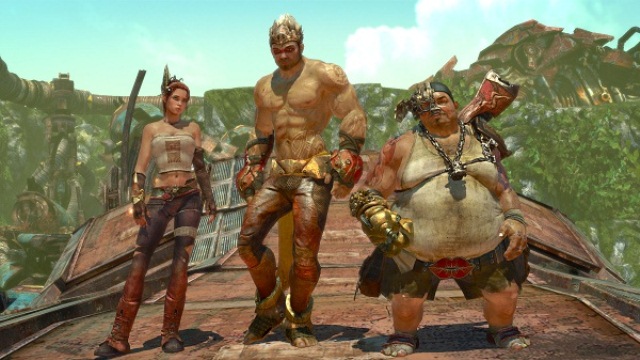
END OF THE ROAD: Once the story is over and the credits roll, it’s hard not to reflect on a game like Enslaved. The writing is of such a high quality, the world so vast and beautiful, the action so cinematic and captivating, that it’s one of those rare games with the ability to truly affect the player, not just effective as a source of entertainment but as an allegory for humanity’s eternal struggles. In a world where the strong will always prey on the weak, to see the tables turned by the latter, altering that established paradigm so completely, is moving. By the end of Enslaved, Monkey is so much softer, Trip so much harder, and both of them are so much stronger.
That Enslaved didn’t make more of a commercial splash will always be one of my biggest questions concerning sales and scores and marketing in the video games industry. If you’ve missed this particular title, I’d urge you to track it down and give it a run. Ignore the fact that it’s not the most challenging game, or that it won’t keep you playing for much longer than 7 hours (unless you pick up the slightly less-compelling, Pigsy-focused DLC) and enjoy the story for what it is, a stirring tale of courage and camaraderie in a crumbling, fading world. Viewed this way, Enslaved: Odyssey to the West is close to a modern masterpiece.
Enslaved: Odyssey to the West was developed by Ninja Theory and published by Namco Bandai. It currently holds a Metacritic Score of 81/100.




